How to Get Published as an Underwater Photographer
Here's an AI-generated image that captures the essence of getting
published as an underwater photographer. It shows the vibrant and diverse
marine life you might encounter and the dedication required to capture these
stunning moments.
Hello, fellow Oceanic Explorers! This week, we’re diving into the exhilarating world of getting your underwater photography published. Whether your goal is to see your work in prestigious magazines, popular websites, or a stunning coffee table book, getting published can elevate your profile and open doors to new opportunities. Here’s a detailed guide to help you navigate these waters.
1. Build a Strong Portfolio
Curate Your Best Work
- Quality Over Quantity: Select only your finest images that showcase your skills and unique perspective. Aim for wide-angle shots, macro images, and diverse marine life. Your portfolio should reflect your ability to handle different underwater conditions and subjects.
- Consistency: Ensure your portfolio maintains a consistent style. This helps editors recognize your signature touch. If you specialize in a particular niche, like macro photography of nudibranchs or wide-angle shots of coral reefs, make sure this is evident.
- Update Regularly: Keep your portfolio fresh by updating it with your latest and best work. This shows that you are active and continuously improving your craft.
Create an Online Presence
- Professional Website: Your website is your digital gallery. Use platforms like Squarespace or Wix to create a clean, professional site. Include a bio, contact information, and links to your social media. Make sure your site is easy to navigate and visually appealing.
- Social Media: Platforms like Instagram, Facebook, and Twitter are excellent for showcasing your work and building a following. Use relevant hashtags like #underwaterphotography, #oceanlife, and #scubadiving to reach a broader audience. Engage with your followers by responding to comments and participating in discussions.
2. Research Potential Publishers
Identify Target Publications
- Magazines: Look for both print and online magazines that focus on diving, marine biology, travel, and nature photography. Some popular ones include National Geographic, Oceanographic Magazine, Dive Photo Guide, and Scuba Diving Magazine.
- Websites and Blogs: Many websites are dedicated to underwater photography and diving. Submit your work to these platforms to gain exposure. Examples include Wetpixel, Underwater Photography Guide, and DivePhotoGuide.
- Books and Calendars: Consider publishers that produce coffee table books and calendars focused on underwater themes. Research which publishers have released similar books and reach out to them.
Understand Submission Guidelines
- Follow Instructions: Each publication has its submission guidelines. Follow them meticulously to avoid immediate disqualification. These guidelines often include specific file formats, resolution requirements, and how to label your files.
- Tailor Your Submissions: Customize your submission to fit the style and audience of each publication. Editors appreciate when you’ve done your homework. For instance, a magazine focusing on marine biology may prefer images that highlight the behavior of marine life, while a travel magazine may prefer vibrant images that showcase the beauty of dive destinations.
3. Perfect Your Pitch
Craft a Compelling Cover Letter
- Introduce Yourself: Briefly introduce who you are, what your background is, and what your passion is for underwater photography. Mention any unique aspects of your experience, such as working in specific regions or with particular marine species.
- Highlight Achievements: Mention any previous publications, awards, or notable projects. This adds credibility to your submission.
- Explain Your Submission: Describe what you’re submitting and why it’s a good fit for their publication. Be concise and focus on the unique aspects of your work.
Provide a Detailed Caption and Description
- Tell a Story: Each photo should come with a caption that tells the story behind the shot. Explain the location, subject, and any interesting details about the dive. For example, share the challenges you faced while capturing the shot or any unique behaviors of the marine life.
- Technical Details: Include the technical aspects of the shot, such as camera settings, equipment used, and post-processing techniques. This information is valuable for editors and readers who are interested in the technical side of photography.
4. Network Within the Industry
Attend Conferences and Workshops
- Join Events: Participate in underwater photography and diving conferences, workshops, and trade shows. These events are great for networking with industry professionals. Examples include the annual DEMA Show, Beneath the Sea, and the Underwater Photographer of the Year awards.
- Build Relationships: Connect with editors, fellow photographers, and other industry insiders. Building relationships can open doors to future publication opportunities. Follow up with contacts you meet and maintain professional relationships.
Engage in Online Communities
- Join Forums and Groups: Engage with communities on platforms like Facebook, Reddit, and specialized photography forums. Share your work, offer feedback, and participate in discussions. Active participation can increase your visibility within the community.
- Collaborate: Collaborate with other photographers, writers, and divers. Joint projects can sometimes lead to publication opportunities. Working with others can also help you learn new techniques and perspectives.
5. Maintain Professionalism
Be Patient and Persistent
- Follow-Up: After submitting your work, follow up politely if you haven’t heard back within a reasonable time frame. Persistence shows your dedication, but be respectful of the editors’ time.
- Handle Rejections Gracefully: Rejections are part of the process. Use them as learning experiences and keep improving your work. Ask for feedback if possible, and use it to enhance your future submissions.
Respect Copyright and Licensing
- Know Your Rights: Understand the terms of publication, including rights to your images and how they will be used. Ensure you retain ownership of your work unless you explicitly agree to transfer rights.
- Negotiate Fairly: Ensure you’re compensated fairly for your work, whether it’s through payment, credits, or both. Understand the market rates and don’t undersell your work.
6. Keep Learning and Improving
Stay Updated
- New Techniques: Keep up with the latest techniques and trends in underwater photography. Continuous learning will keep your work fresh and exciting. Subscribe to photography journals, attend workshops, and follow influential photographers.
- Feedback: Seek feedback from peers and mentors. Constructive criticism can help you grow and refine your skills. Join critique groups or workshops where you can receive feedback on your work.
Experiment and Innovate
- Try New Approaches: Don’t be afraid to experiment with different styles, equipment, and editing techniques. Innovation can make your work stand out. For example, try shooting with different lighting setups, using creative compositions, or experimenting with post-processing techniques.
- Document Your Process: Keep a journal or blog about your experiences and techniques. Sharing your journey can attract followers and create engagement with your audience.
Getting published as an underwater photographer takes dedication, persistence, and a passion for capturing the beauty of the underwater world. Follow these steps, and you’ll be well on your way to seeing your work in print and inspiring others with the magic of the ocean. Until next time, keep exploring and capturing those stunning underwater moments!
Stay Connected
Follow my blog for more tips and tutorials on underwater photography. Let's dive deeper into the art and craft of capturing the marine world!
Subscribe to my blog for more tips and tutorials on underwater photography. Don’t forget to share your processed photos on social media using the hashtag #RobertHerbPhotography. I look forward to reviewing your results.
New Online Training Program
I am excited to announce that I am creating an online training program to teach underwater hobbyists and enthusiasts how to enhance their photos using Adobe Lightroom. If you are interested in this training, please contact me at bob@robertherb.com to express your interest and to be notified about the details and start date of the classes.
Stay tuned and "Follow" for upcoming blogs on underwater photography tips and tricks for more in-depth insights. Please leave your comments and suggestions. Enjoy your diving and shooting experience!
I am eagerly anticipating your valuable feedback and suggestions.
Sincerely,
Bob Herb
|
|





Comments
Post a Comment
Please let me know your comments.